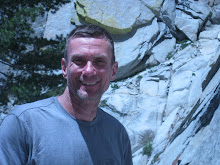Arriving in Paradise Forks late Friday night, I found Ryan, Marcus, and Martin sitting around a blazing campfire. Camping is free in this area and downed, dry wood abounds—two requirements for a perfect stay!
On Saturday we drove to Volunteer Canyon, but unfortunately Ryan developed slight van trouble and we all decided to head back into town and get it fixed without delay. We drove to the town of Williams, where Ryan had had a previous good garage experience, and once again he received a fair shake on tightening up a loose wheel bearing ($10, from the garage on the east side of the highway on the very north end of town).
Marcus and Martin decided to treat us all to an all-American dinner of hamburgers grilled over an open flame, replete with Milwaukee's best. We broke out my slack line for the first time; Ryan and myself were lucky to come away with only minor injuries, while Marcus and Martin had obviously spent some time on the line before.
Sunday saw us once again trying to skirt the crowds at Paradise Forks proper and drove out to Sycamore point. It was my first view of a Grand Canyon-type vista, with a sedimentary layer sandwiched between a basalt layer on top and limestone below. From ancient seabed to ancient river to relatively recent volcanic plain, all in one sweeping vista!
The view was much better than the climbing, which was bushy at the bottom, loose in the middle, and extremely loose at the top. After a few climbs, we gave up and drove to the Forks for my first views of Paradise.
The only basalt I've experienced is Vantage (Frenchmen's Coulee) and the Tieton River area, both in Washington. Vantage rock is somewhat suspect, at least in my book. The Tieton River is a definite step up in quality. But Paradise Forks takes basalt climbing to a whole new level. Perfect cracks on perfect rock, for the most part very easily protectable. There are precious few face climbs here, and only two bolted routes among the 160+ climbs packed into a very small area. If there is no crack, then there is no climb. The column faces are slick and relatively devoid of hand and footholds. Stemming is possible on some climbs, but the margin of error for the feet is small—the stem goes from marginal to non-existent in milliseconds and without warning, at least to the newcomer. And if the crack is off-size for hands or fingers, well then, it's just off-size and you'd better get used to it! It's not that there are no constrictions for the hands, just that there are often none when you most need one. It's pure jamming technique, and I feel like I am in a giant crack climbing classroom.
After three climbs the sun is quickly disappearing and we head back to our campsite for more food and slackline fun. The next day is more climbing in Paradise followed by a dip in a nearby lake, and the time passes unnoticed. It is a measure of how quickly one can make friends on the road. I've known these three fellow travelers for a week, and yet somehow we've thrown our lot together and share in the camaraderie of the climber.

No comments:
Post a Comment